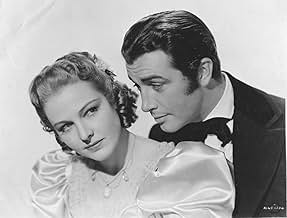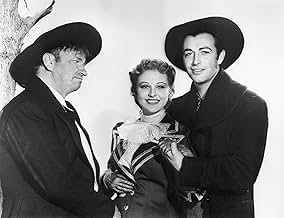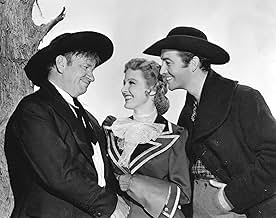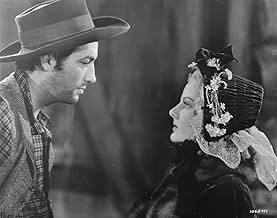Agrega una trama en tu idiomaIt starts in 1844 in Maryland, where Blake Cantrell, plantation owner with slaves, is forced by debts to sell his estate and his people. Then he leaves for Cumberland, looking for a job (fir... Leer todoIt starts in 1844 in Maryland, where Blake Cantrell, plantation owner with slaves, is forced by debts to sell his estate and his people. Then he leaves for Cumberland, looking for a job (first time in his life), and ends up working for a stagecoach line run by Boss Starkey and ow... Leer todoIt starts in 1844 in Maryland, where Blake Cantrell, plantation owner with slaves, is forced by debts to sell his estate and his people. Then he leaves for Cumberland, looking for a job (first time in his life), and ends up working for a stagecoach line run by Boss Starkey and owned by Susan Griffith. Before love and friendship can triumph, Cantrell will have to commi... Leer todo
- Dirección
- Guionistas
- Elenco
- Premios
- 2 premios ganados en total
- Whittingham P. Talbot
- (escenas eliminadas)
- Chinese Cook
- (escenas eliminadas)
- (as Lee Tung Foo)
Opiniones destacadas
The film "Stand Up And Fight" (USA, 1939) depicts a fictional story within a complex and multi-faceted historical background. The story is set in 1844 Cumberland Maryland, which became a key east-west point along the westward settler route through the Appalachian Mountains, and a key north-south point along the underground railroad assisting escaped slaves -- when the B&O Railroad opened in 1842, the nation's first Telegraph lines went operational, and the C&O Canal opened in 1850 -- all using rights of way along the same Potomac River that flows past Cumberland and on down past Washington DC.
Within this context the story concerns a pre-Civil War racket involving the capture and reselling of fugitive slaves in a key border location between abolitionist North and slavery South just as the railroad was beginning to compete hard against the stagecoach and wagon trains, and the canal was about to move huge quantities of coal out of the mountains. Most of the laborers building the railroad, the canal, the telegraph and the coal mines were uneducated and impoverished recent escapees from the British-oppressed serf plantation of Ireland.
Mid-way along that 120-mile Potomac River route between Cumberland and Washington is strategic Harper's Ferry, where the Shenandoah river meets the Potomac and where John Brown's Raid on an armory in 1859 began to galvanize large portions of the nation's public opinion on each side of the slavery/secession issue. At the time of Brown's raid, Harper's Ferry was in the big slavery (Confederate) state of Virginia, which was also the state just across the river in Cumberland in the abolitionist (Union) state of Maryland.
The American Civil War began in April 1961. West Virginia became a state a few months later following the Wheeling Conventions of 1861, in which abolitionist delegates from 30 northwestern Virginia counties decided to break away from Virginia. West Virginia immediately became a key Civil War border state and was formally admitted to the Union in June 1863. West Virginia was the only state to form by separating from a Confederate state, the first to separate from any state since Maine separated from Massachusetts in 1820.
The north-south terrain of the Appalachian Mountains is what enabled General Lee to move a huge Confederate army through the Shenandoah all the way north into Pennsylvania to meet a similar huge Union army at Gettysburg – far behind Northern "lines" – during the first three days of July in 1863.
I didn't expect much from this movie, and was thoroughly and positively surprised by the sharp writing and ebullient acting, and contrary to many A-movies of its day its aim is no way an aesthetic 'arty' one. Made in 1939, this movie addresses all sorts of controversial issues, and they have a way of taking you by surprise along the way. The movie is really about abolitionism and treats its subject with remarkable subtlety, although why and how the lynch-mob, the one that we encounter in the last third of the film, goes after white man Starkey is never made quite clear. Cantrell's gradual moral reform is well-explained and plausible, not least because of Taylor's warmth and humanity in the part. Yes, he is handsome, but here it is almost besides the point. Wallace Beery has a field day with the larger-than-life captain, very cleverly balancing on the edge of buffoonery but with plenty of edge and ambiguity.
See it, it makes a deep impression.
The story is one of the stranger ones I've ever seen concerning slavery. It isn't really bad...just very, very unusual--especially in its way of portraying the fugitive slave trade. The film begins with Robert Taylor selling off his plantation and slaves because of his debts. It's obvious that he's pretty attached to his slaves and makes sure the families aren't separated--but he STILL sells them like they are property. So, seeing him working for the abolitionist cause later in the film is a bit of a surprise.
A bit later, officials with the B&O Railroad try to hire Taylor as an agent to investigate the illegal slave trade and how it might relate to a local transportation company. I liked seeing the old fashioned trains from the 1840s that you see in the film, but Taylor wasn't as impressed nor was he willing to take the railroad's offer. However, oddly, investigating this trade is EXACTLY what Taylor ends up doing--and it hits close to home when one of his old slaves is killed by the scum behind the scheme.
Taylor's nemesis throughout the film is the mean and blustery Wallace Beery. His acting, as usual, is far from subtle and he chews up practically every scene in which he appears. As a result, Taylor's good acting is all the more obvious! Overall, an interesting film--mostly because other films made around the same time didn't seem to care much about the plight of slaves. By comparison, think about the way Blacks are portrayed in "Gone With the Wind" which also came out the same year. Sure, it's a great film, but it also made slavery seem not so bad! So "Stand Up and Fight" should at least be given some credit for its rather progressive theme. The only major complaint I had about the film was the ending--it seemed a bit weak.
¿Sabías que…?
- TriviaThe $850 that Blake has left over from his estate in 1844 would equate to about $27,800 in 2015.
- ErroresCharles Bickford's character is named Morgan throughout the movie, but he's called Arnold in the closing credits.
- ConexionesReferenced in Electrical Power (1938)
Selecciones populares
Detalles
- Tiempo de ejecución
- 1h 37min(97 min)
- Relación de aspecto
- 1.37 : 1







































